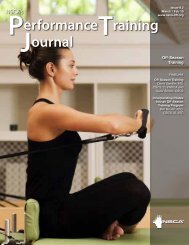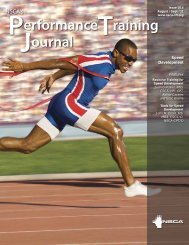PTJ Sep Oct 2010.pdf
PTJ Sep Oct 2010.pdf
PTJ Sep Oct 2010.pdf
You also want an ePaper? Increase the reach of your titles
YUMPU automatically turns print PDFs into web optimized ePapers that Google loves.
in the gym<br />
Kyle Brown, CSCS<br />
about the<br />
AUTHOR<br />
Kyle Brown is a health<br />
and fitness expert<br />
whose portfolio<br />
includes everything<br />
from leading<br />
workshops for Fortune<br />
500 companies and<br />
publishing nutrition<br />
articles in top-ranked<br />
fitness journals, to<br />
training celebrity<br />
clientele—from pro<br />
athletes to CEOs<br />
to multiplatinum<br />
recording artists. Kyle’s<br />
unique approach to<br />
health and fitness<br />
emphasizes nutrition<br />
and supplementation<br />
as the foundation for<br />
optimal wellness. After<br />
playing water polo<br />
for Indiana University,<br />
as well as in London,<br />
Kyle became involved<br />
in bodybuilding and<br />
fitness for sportspecific<br />
training. Kyle<br />
is the creator and Chief<br />
Operating Officer for<br />
FIT 365—Complete<br />
Nutritional Shake<br />
(www.fit365.com).<br />
Heavy Resistance Instead<br />
of High Repetition for<br />
Six-Pack Abs<br />
While mainstream fitness enthusiasts have progressed in<br />
the gym—incorporating balance and stability exercises to<br />
strengthen their core—most are still hung up on doing<br />
hundreds of sit-ups or crunches everyday to lose belly fat<br />
and get six-pack abs. They often fall victim to two wellmarketed<br />
myths: 1) You can reduce belly fat by training<br />
your abdominals and 2) Abdominals should be trained<br />
differently than the other muscles in your body. The truth<br />
is that your abdominals apply to the same scientific principles<br />
of every other muscle group in your body.<br />
Many people still believe the outdated fitness myth that if<br />
they do crunches with high-repetition and low-resistance<br />
every day, they can reduce abdominal fat. The erroneous<br />
belief behind fat reduction is that if you train a muscle<br />
that is covered by body fat, the fat will go away, turn into<br />
muscle, and get “toned.” Contrary to popular belief, there<br />
is no way to reduce only abdominal fat with abdominal<br />
training exercises. If you could, everyone who chewed<br />
bubble gum would have skinny faces.<br />
The other myth is that abdominals should be trained differently<br />
than other muscles in the body and do not apply<br />
to the same scientific principles. Many believe that<br />
abdominal muscles should be trained everyday with high<br />
repetition sets and no resistance. One main reason why<br />
people, especially women, do not use resistance when<br />
training their abdominals is because they do not want to<br />
get too muscular. They want to “tone” their muscles not<br />
build muscle. Yet, there is no such thing as toning a muscle.<br />
It is an erroneously used marketing term that helps<br />
sell magazines and exercise equipment. Muscles can either<br />
hypertrophy (grow) or atrophy (shrink). This applies<br />
to all muscles, including the abdominals.<br />
the overload principle. The human body is involved in a<br />
constant process of adapting to stresses or lack of stresses<br />
placed upon it. When you stress the body in a manner it is<br />
unaccustomed to (overload), the body will react by causing<br />
physiological changes (adaptation) to be able to handle<br />
that stress in a better way the next time it occurs (1).<br />
These concepts make sense to the average fitness enthusiast<br />
when it comes to training other muscle groups;<br />
i.e., they would not expect their arms to look any better if<br />
they performed 300 curls with a broomstick seven days a<br />
week. Therefore, strength training 2 – 3 times a week, with<br />
moderate to heavy resistance, moderate repetitions, rest<br />
in between and a variety of exercises to target different<br />
areas applies to the abdominals as well as all other muscle<br />
groups. For example, cable crunches on a resistance<br />
ball, cable rope crunches, hanging abdominal raises with<br />
dumbbell between legs, cable rotations, and seated abdominal<br />
crunches are the types of exercises that will yield<br />
the desired results. •<br />
References<br />
1. McArdle, WD, Katch, FI, and Katch, VL. (2000).<br />
Essentials of exercise physiology (2nd ed.). Baltimore:<br />
Lippincott, Williams, & Wilkins.<br />
The purpose behind training the abdominal muscles with<br />
resistance is to stress them to the point where they must<br />
adapt to meet the unaccustomed demands. This is called<br />
nsca’s performance training journal • www.nsca-lift.org • volume 9 issue 5 7





